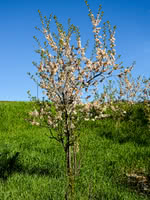Mon-Fri 9am - 5pm Mountain time
Manchurian Apricot vs Canada Plum & American Plum
Prunus nigra and americana
Prunus armeniaca var. mandshurica
Canada and American Plum are almost identical in appearance and growth needs. These plants are short and stout fruit trees native to North America.
This hardy ornamental is excellent for both city dwellings as well as rural areas. During the spring, the white and pink blossoms are long lasting. The tasty fruit is suitable for fresh eating, baking, and preserves. These trees are not widely distributed and pure seed can be hard to come by.
Both are commonly used as rootstock and are considered universal pollinizers for other plum varieties.
Manchurian Apricot is a winter-hardy relative of the native plum. This tree can stand some drought, but will not handle standing water or saturated moist soils. It can be used in shelterbelts, hedges, or as an ornamental. Manchurian Apricot will also attract songbirds, rabbits, and other rodents if left uncontrolled.
This tree will produce fruit once it reaches maturity at between two and five years old. Other famous cultivars of Manchurian Apricot include Scout Apricot, Moongold, and many more.

